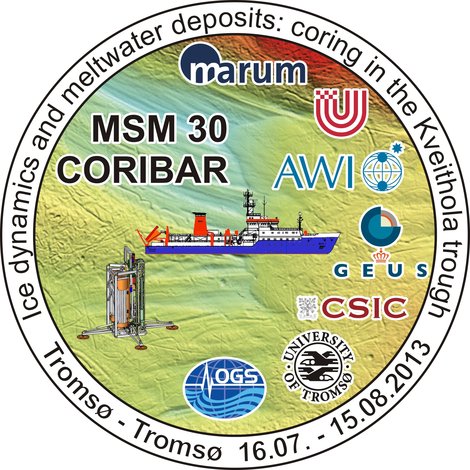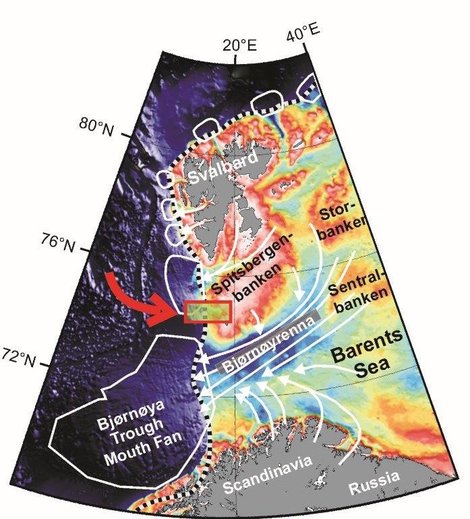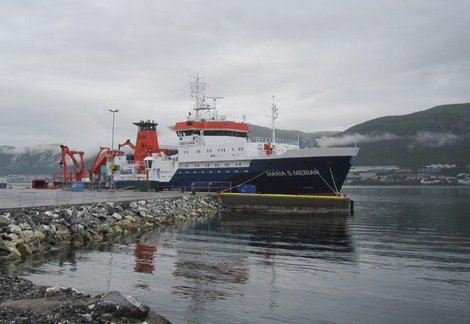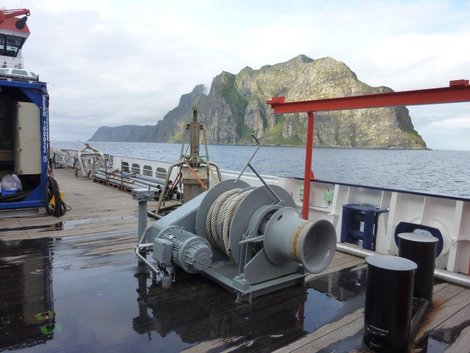Page path:
- Home
- Research
- Expeditions
- 2013
- MSM30
MSM30
RV MARIA S.MERIAN 30 - CORIBAR
16.07. - 15.08.2013
Ice dynamics and meltwater deposits: coring in the Kveithola trough, NW Barents Sea
16.07. - 15.08.2013
Ice dynamics and meltwater deposits: coring in the Kveithola trough, NW Barents Sea
The CORIBAR project
The rate of ice-sheet retreat across polar continental shelves, ice-stream collapses and their relationships to short-term sea-level changes during deglacial periods are a matter of debate. However, if the associated catchment area and ice reservoir of an ice-stream system are locally restricted, the deposits which typically form in such an environment record sensitively these ice advance and retreat dynamics as a result of climatic variability. Rapid deglacial climatic changes in the northern Atlantic realm have forced the local ice sheet of the Kveithola Trough and the regional sea-ice cover to respond sensitively and rapidly. This ice dynamics is assumed to have left particular footprints in the form of various glaci-genic deposits:
1. The continental-slope deposits (Trough Mouth Fan systems, TMF) recorded these deglacial ice dy-namics sensitively by the formation of plumite (meltwater suspension plume deposits) successions but have also interacted with the ocean-current system. We want to understand the mechanisms of generation and dispersal patterns of sediment-laden meltwater discharges and investigate the sedimentation and stability dynamics on glacially influenced continental slopes in response to the cyclic glacier-induced sediment deposition. Further, we plan to analyze the palaeoceanographic and climatic changes since MIS 5 (6?), concentrating on glacial-interglacial and shorter-term millennial variability.
2. Variations in meltwater discharge, ice-stream dynamics, and sea-level rising were related to the deglacial ice sheet retreat history and are recorded by the ice-margin deposits (Grounded-Zone Wedge systems, GZW) inside the Kveithola trough. We want to reconstruct the chronology of the deglaciation stages of the Svalbard/Barents Sea Ice Sheet for developing the conceptual understanding of ice-stream dynamics as well as in the context of rapidly changing climatic and environmental conditions since the last glacial maximum.
3. The nearby shallow continental shelf which must have acted as the local material source for the ice-stream delivered sediments. Confined depocenters are expected, thus, to contain information on these processes and the connection between the surrounding bank areas and the trough itself. We want to understand the formation dynamics of such shelf depocenters and to use these deposits as archives for environmental changes and for the backtracking of material sources, pathways and the driving forces leading to sediment dispersal.
4. The sea-ice history is closely linked to the climatic variability with strong impact on the marine productivity and deep-water formation processes. We want to reconstruct former sea-ice positions and their dynamics, and to assess the climate-model credibility in simulating high-latitude ocean and sea-ice processes by verifying simulations under palaeo-boundary conditions with sea-ice proxy reconstructions.
The rate of ice-sheet retreat across polar continental shelves, ice-stream collapses and their relationships to short-term sea-level changes during deglacial periods are a matter of debate. However, if the associated catchment area and ice reservoir of an ice-stream system are locally restricted, the deposits which typically form in such an environment record sensitively these ice advance and retreat dynamics as a result of climatic variability. Rapid deglacial climatic changes in the northern Atlantic realm have forced the local ice sheet of the Kveithola Trough and the regional sea-ice cover to respond sensitively and rapidly. This ice dynamics is assumed to have left particular footprints in the form of various glaci-genic deposits:
1. The continental-slope deposits (Trough Mouth Fan systems, TMF) recorded these deglacial ice dy-namics sensitively by the formation of plumite (meltwater suspension plume deposits) successions but have also interacted with the ocean-current system. We want to understand the mechanisms of generation and dispersal patterns of sediment-laden meltwater discharges and investigate the sedimentation and stability dynamics on glacially influenced continental slopes in response to the cyclic glacier-induced sediment deposition. Further, we plan to analyze the palaeoceanographic and climatic changes since MIS 5 (6?), concentrating on glacial-interglacial and shorter-term millennial variability.
2. Variations in meltwater discharge, ice-stream dynamics, and sea-level rising were related to the deglacial ice sheet retreat history and are recorded by the ice-margin deposits (Grounded-Zone Wedge systems, GZW) inside the Kveithola trough. We want to reconstruct the chronology of the deglaciation stages of the Svalbard/Barents Sea Ice Sheet for developing the conceptual understanding of ice-stream dynamics as well as in the context of rapidly changing climatic and environmental conditions since the last glacial maximum.
3. The nearby shallow continental shelf which must have acted as the local material source for the ice-stream delivered sediments. Confined depocenters are expected, thus, to contain information on these processes and the connection between the surrounding bank areas and the trough itself. We want to understand the formation dynamics of such shelf depocenters and to use these deposits as archives for environmental changes and for the backtracking of material sources, pathways and the driving forces leading to sediment dispersal.
4. The sea-ice history is closely linked to the climatic variability with strong impact on the marine productivity and deep-water formation processes. We want to reconstruct former sea-ice positions and their dynamics, and to assess the climate-model credibility in simulating high-latitude ocean and sea-ice processes by verifying simulations under palaeo-boundary conditions with sea-ice proxy reconstructions.
The Scientific Consortium
CORIBAR is an international consortium of the following collaborative partner institutes:
MARUM - Center for Marine Environmental Sciences, University of Bremen, Germany
AWI - Alfred Wegener Institute for Polar and Marine Research, Bremerhaven, Germany
CSIC - Institut de Ciències del Mar, Consejo Superior de Investigaciones Científicas, Barcelona, Spain
GeoB - Faculty of Geosciences, University of Bremen, Germany
GEUS - Geological Survey of Denmark and Greenland, Copenhagen, Denmark
OGS - Instituto Nazionale di Oceanografia e di Geofisica Sperimentale, Trieste, Italy
UiT - Department of Geology, University of Tromsø, Norway
CORIBAR is an international consortium of the following collaborative partner institutes:
MARUM - Center for Marine Environmental Sciences, University of Bremen, Germany
AWI - Alfred Wegener Institute for Polar and Marine Research, Bremerhaven, Germany
CSIC - Institut de Ciències del Mar, Consejo Superior de Investigaciones Científicas, Barcelona, Spain
GeoB - Faculty of Geosciences, University of Bremen, Germany
GEUS - Geological Survey of Denmark and Greenland, Copenhagen, Denmark
OGS - Instituto Nazionale di Oceanografia e di Geofisica Sperimentale, Trieste, Italy
UiT - Department of Geology, University of Tromsø, Norway
Strategy
The main intention of this international initiative between the collaborative institutions aimed at obtaining 70-m long sediment cores with the MARUM owned seafloor drill rig MeBo, flanked by a sediment-acoustic and conventional coring program.
Continental Slope drilling sites on the Kveithola Trough-Mouth Fan
The locations of two MeBo sites are selected where the glacially induced debris flow deposits are either absent or so reduced, that a continuous record of glacial-marine/meltwater plume sedimentation is accessible spanning the last two to three glacial stages (MIS (6?-) 5, 4-3, 2-1). These continental-slope records will provide an open-water counterpart to the proximal records of deglaciation to be obtained from the GZWs and the shallow continental shelf and will also strongly extend the few available short palaeoclimatic records from the Storfjorden TMF.
Continental shelf drilling sites inside the Kveithola Trough
A transect of 5 MeBo sites will sample the post-glacial (Holocene), deglacial, proglacial, and subglacial sedimentary sequence. Three sites are located in the outer part of the trough at the toe of (or immediately in front of) each GZW, and will allow dating each phase of stillstand during general ice-sheet retreat. Two sites are located in the inner part of the trough on a 40-m thick sedimentary drift, with a high-resolution sedimentary record of the overlying post-glacial ice-retreat history. This core transect will provide ages for the phases of ice-stream retreat and palaeoceanographic information
throughout the retreat of the ice grounding line.
Shallow continental shelf coring sites (outside the Kveithola Trough)
Preferable targets are Late-Quaternary depression fills, confined sediment depocentres, drift bodies, sed-iment drapes, and marginal trough deposits. These depocenters will serve as environmental archives to reveal a) the development of local sedimentary dynamics, b) information on the proximal material sources, and c) changes in the Holocene climatic/oceanographic history as a complement to the records from the TMF. Another important aspect is d) to decipher deglacial to Holocene sea-level dynamics.
The main intention of this international initiative between the collaborative institutions aimed at obtaining 70-m long sediment cores with the MARUM owned seafloor drill rig MeBo, flanked by a sediment-acoustic and conventional coring program.
Continental Slope drilling sites on the Kveithola Trough-Mouth Fan
The locations of two MeBo sites are selected where the glacially induced debris flow deposits are either absent or so reduced, that a continuous record of glacial-marine/meltwater plume sedimentation is accessible spanning the last two to three glacial stages (MIS (6?-) 5, 4-3, 2-1). These continental-slope records will provide an open-water counterpart to the proximal records of deglaciation to be obtained from the GZWs and the shallow continental shelf and will also strongly extend the few available short palaeoclimatic records from the Storfjorden TMF.
Continental shelf drilling sites inside the Kveithola Trough
A transect of 5 MeBo sites will sample the post-glacial (Holocene), deglacial, proglacial, and subglacial sedimentary sequence. Three sites are located in the outer part of the trough at the toe of (or immediately in front of) each GZW, and will allow dating each phase of stillstand during general ice-sheet retreat. Two sites are located in the inner part of the trough on a 40-m thick sedimentary drift, with a high-resolution sedimentary record of the overlying post-glacial ice-retreat history. This core transect will provide ages for the phases of ice-stream retreat and palaeoceanographic information
throughout the retreat of the ice grounding line.
Shallow continental shelf coring sites (outside the Kveithola Trough)
Preferable targets are Late-Quaternary depression fills, confined sediment depocentres, drift bodies, sed-iment drapes, and marginal trough deposits. These depocenters will serve as environmental archives to reveal a) the development of local sedimentary dynamics, b) information on the proximal material sources, and c) changes in the Holocene climatic/oceanographic history as a complement to the records from the TMF. Another important aspect is d) to decipher deglacial to Holocene sea-level dynamics.

Chief scientist / contact person:
Dr. Till Hanebuth, MARUM
Marine Sedimentation Systems
Room: MARUM 2, 1010
Phone: 0421 218 - 65200
E-Mail: [Bitte aktivieren Sie Javascript]
Dr. Till Hanebuth, MARUM
Marine Sedimentation Systems
Room: MARUM 2, 1010
Phone: 0421 218 - 65200
E-Mail: [Bitte aktivieren Sie Javascript]





